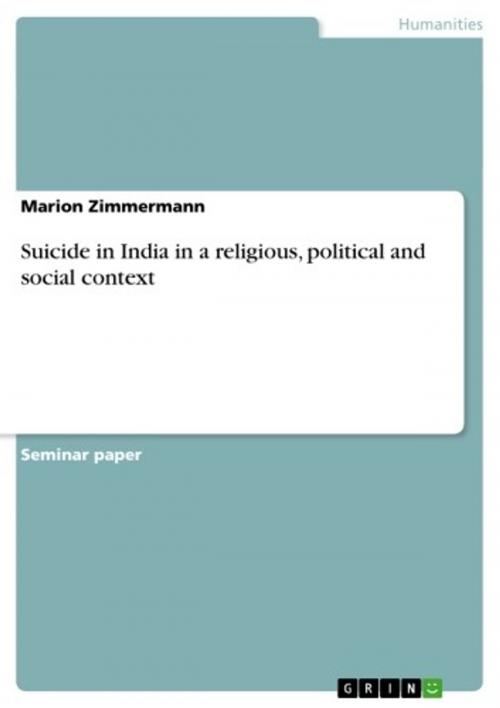| Author: | Marion Zimmermann | ISBN: | 9783638877367 |
| Publisher: | GRIN Publishing | Publication: | December 17, 2007 |
| Imprint: | GRIN Publishing | Language: | English |
| Author: | Marion Zimmermann |
| ISBN: | 9783638877367 |
| Publisher: | GRIN Publishing |
| Publication: | December 17, 2007 |
| Imprint: | GRIN Publishing |
| Language: | English |
Seminar paper from the year 2002 in the subject Ethnology / Cultural Anthropology, grade: 2,3, University of Heidelberg (Südasien Institut, Abteilung Ethnologie), course: Gender, Gesundheit und Politik in Südasien, 13 entries in the bibliography, language: English, abstract: Suicide is the intentional destruction of one´s own life. The most people who commit suicide do it with the hope for rescue, because in reality they don't want die. This self-destroying act is rather a cry for help and a desperate attempt to change hopeless situtations. Only less of all suicides happen deliberate without chance for help. In general men use harder methods to kill themselves than women, e.g. very often men shoot or hang themselves and women use more likely an overdose of sleeping pills (Digel, Werner (Hg.), Kwiatkowski, Gerhart (Hg.) 1987: 96). This informations would stand for that men are more determined to die definite than women who more likely hope for rescue. Indeed the rate of suicide committed by men is in the most countries in general higher than that of women (www : WHO 2001 b). The general causes of suicide and high- risk groups are mostly aged people, divorced, unemployed, social isolated, addict (especially alcoholics), psychically unbalanced and those who already attempted suicide in the past. Problems of women are often lovesickness, marital and family conflicts, problems of men are economic and social (especially professional) difficulties. The best prevention against suicides is the support of social relationships and organizations, which should be accessible for all people who need help (Digel, Werner (Hg.), Kwiatkowski, Gerhart (Hg.) 1987: 96). In the following chapters I descibe different kind of suicide in India. After general informations about suicide, I explain suicide in the context of religion, politic and society. Therefore I make following categories: a) religious suicide, b) political suicide, and c) social suicide. The chapter about social suicide is more detailed. Social suicide is seen as a public health problem. Positive changes can be achieved through prevention and care programs which I deal with at the end of this essay. I will not make a detailed comparing between India and other countries. I make no specific separation or detailed comparing between different groups, like young-old, men-women, different castes, different social strata, etc. My informations are hold very general.
Seminar paper from the year 2002 in the subject Ethnology / Cultural Anthropology, grade: 2,3, University of Heidelberg (Südasien Institut, Abteilung Ethnologie), course: Gender, Gesundheit und Politik in Südasien, 13 entries in the bibliography, language: English, abstract: Suicide is the intentional destruction of one´s own life. The most people who commit suicide do it with the hope for rescue, because in reality they don't want die. This self-destroying act is rather a cry for help and a desperate attempt to change hopeless situtations. Only less of all suicides happen deliberate without chance for help. In general men use harder methods to kill themselves than women, e.g. very often men shoot or hang themselves and women use more likely an overdose of sleeping pills (Digel, Werner (Hg.), Kwiatkowski, Gerhart (Hg.) 1987: 96). This informations would stand for that men are more determined to die definite than women who more likely hope for rescue. Indeed the rate of suicide committed by men is in the most countries in general higher than that of women (www : WHO 2001 b). The general causes of suicide and high- risk groups are mostly aged people, divorced, unemployed, social isolated, addict (especially alcoholics), psychically unbalanced and those who already attempted suicide in the past. Problems of women are often lovesickness, marital and family conflicts, problems of men are economic and social (especially professional) difficulties. The best prevention against suicides is the support of social relationships and organizations, which should be accessible for all people who need help (Digel, Werner (Hg.), Kwiatkowski, Gerhart (Hg.) 1987: 96). In the following chapters I descibe different kind of suicide in India. After general informations about suicide, I explain suicide in the context of religion, politic and society. Therefore I make following categories: a) religious suicide, b) political suicide, and c) social suicide. The chapter about social suicide is more detailed. Social suicide is seen as a public health problem. Positive changes can be achieved through prevention and care programs which I deal with at the end of this essay. I will not make a detailed comparing between India and other countries. I make no specific separation or detailed comparing between different groups, like young-old, men-women, different castes, different social strata, etc. My informations are hold very general.















